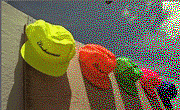|

Introduction to digital halftoning
Digital image halftoning is the process of
reducing the bit-depth of an image for display on devices
capable of reproducing smaller number of graylevels than those
present in the original high bit-depth (a.k.a. continuous-tone
image) image. Image halftoning takes advantage of the spatial
averaging of the human eye to distribute the quantization error in
such a way that the reduced bit-depth image is visually close to the
continuous-tone image as possible. The classic example is a
bi-level printer that is capable of either placing a dot of
ink/toner on the paper or not (hence the word
halftone). Printed images that appear to have continuous shades
are created by an ingenious spatial distribution of dots using a
halftoning algorithm. Halftoning theory is used in a number of image
rendering systems such as printers, projectors and displays.
The challenge in image halftoning is to tailor
the halftoning algorithm to a rendering device in order to optimize
the output quality. For example, inkjet printers are able to
reproduce isolated printer dots very well and could also allow
multiple drops of ink at the same location. Laser printers require
dot-clusters for a stable printing process. They also allow
modification of the pulse width of lasers to produce dots of
different sizes (this process is called pulse width modulation,
a.k.a PWM). Artifacts due to the interactions among color planes and
due to printing process imperfections are also key concerns. A good
halftoning algorithm must utilize such information to deliver output
that is of high visual quality.
Conventional halftoning relies on dot size
modulation (a.k.a. amplitude modulation (AM)) to reproduce tones
since the dot centers are laid out on a fixed grid. The dot sizes
increase to represent a darker tone and decrease to represent a
lighter tone. Halftoning methods that use a fixed dot size (of
typically one pixel) and modulate the density or frequency of the
dots to reproduce continuous-tone are called FM (frequency
modulation) methods. Thus the dots get closer together to represent
a darker tone and further apart to represent a lighter tone.
Halftones generated by FM halftoning methods are refered to as
blue-noise halftones since their pattern power spectra are
concentrated in the high-frequencies. AM-FM halftones (a.k.a
green-noise halftones) are hybrid halftones that aim to
achieve a balance that takes advantage of the desirable qualities of
both AM and FM halftones.
Selected HP Labs published contributions
1. Theory of blue-noise halftoning
2. The void and cluster method for dither array
generation
3. ColorSmooth dither
4. Image Resolution Enhancement Technology
(IRET)
5.
ImageSmart halftoning
6. Error diffusion with minimum
brighness variation
7. Theory of donut filters for optimal AM-FM
screening
Contact:
For more information about halftoning research at
HP Labs, please e-mail Qian Lin (qian.lin@hp.com), Robert Ulichney (bob.ulichney@hp.com)
or Niranjan Damera-Venkata (niranjan.damera-venkata@hp.com)
|
